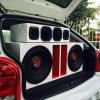Hello guys, rookie electronic technic here  So, i'm attempting to making a active speaker box to challenge myself.
So, i'm attempting to making a active speaker box to challenge myself.
My idea is to make a miniature of a automotive speaker box with a good quality and loud sound (and reliable of course) for my PC or whatever.
It's a little incomplete yet, it's missing the amplifiers (still picking up the best ones) and a final power supply circuit. The crossovers are finished (i hope).
The specs until now are:
According to ohms law, i need 12,5A at 12V to reach 150W. It's pretty easy to get this in a positive power supply, but it's needed a negative too? A 7812 and a 7912 with current boosters will make the work?
I figure out that a 24V-15A transformer is too expansive so i'm thinking in a 12v-15A switching power supply from some online shop...but if i need a negative supply, i can't think in a alternative for now...
so i'm thinking in a 12v-15A switching power supply from some online shop...but if i need a negative supply, i can't think in a alternative for now...
I (hope that) have no problems with the crossovers and the amps, my doubts are about making the power supply. But i accept suggestions
My idea is to make a miniature of a automotive speaker box with a good quality and loud sound (and reliable of course) for my PC or whatever.
It's a little incomplete yet, it's missing the amplifiers (still picking up the best ones) and a final power supply circuit. The crossovers are finished (i hope).
The specs until now are:
- 12V/15A Power supply
- 4 way 2-order active crossover with TL074
- Mid-High and High amp: 1xTDA2822 (2x 2W@4Ω)
- Mid-Low amp: 1xTDA7294 (1x 100W@4Ω)
- Low amps: 1xTDA2030 (1x 10W @8Ω) and 1x TDA7240 (1x 16W @6Ω)
- Some cellphones speakers to mid-high and high drivers (Moto E398, Samsung Galaxy Y and Moto XT925 for curiosity)
- 3x C3576 3" 40W@6Ohms Sony speakers for mid-low drivers
- Some 3"/5W and 4"/15W speakers for low drivers
According to ohms law, i need 12,5A at 12V to reach 150W. It's pretty easy to get this in a positive power supply, but it's needed a negative too? A 7812 and a 7912 with current boosters will make the work?
I figure out that a 24V-15A transformer is too expansive
I (hope that) have no problems with the crossovers and the amps, my doubts are about making the power supply. But i accept suggestions
Attachments
Last edited:






